Increased competition threatens Nvidia

Nvidia's interim report today has the potential to send the S&P500 and the Nasdaq both up and down. One threat to Nvidia's high share price is the increasing competition from AMD and Intel in the Graphics Processing Unit market (GPU). Major cloud providers such as Google, Amazon and Microsoft are also developing their own chips to enhance their cloud services.
Case of the week: Nvidia reports this week
Expect future volatility
Nvidia is scheduled to announce its third quarter results today, 20 November. Analysts are expecting revenues of $33.07 billion and adjusted earnings per share (EPS) of $0.74. These figures represent sequential growth rates of 10% and 10.44%, respectively, going by the comparable figures from Q2. Furthermore, the median Wall Street consensus calls for Nvidia to grow revenue at a Cumulative Average Growth Rate (CAGR) of around 17% through 2030, which is impressive given the company's size and profitability. Free cash flow (FCF) is also expected to grow until 2027.
However, if Nvidia simply hits the revenue and earnings numbers that analysts are expecting, then its growth will slow from the previous quarter's growth rate. In Q2, the company's revenues grew 12% sequentially and its earnings grew 20% sequentially. The expected growth rate for Q3 therefore represents a significant slowdown.
According to TechSpot, Nvidia had an 88% share of the GPU market in Q1 2024, up from 80% a year earlier. This dominance is significant, especially as competition heats up. Major rivals such as AMD and Intel are actively introducing new products to challenge Nvidia's lead. For example, AMD has launched its Instinct MI325X accelerator, while Intel is pushing technologies such as its Lunar Lake AI chip and Gaudi 3 accelerator.
In addition, major cloud providers such as Google, Amazon and Microsoft are developing custom chips to enhance their cloud services. This trend towards proprietary silicon could reduce their reliance on Nvidia's GPUs.
As these competitors intensify their efforts, Nvidia’s market share may come under pressure. Although the company remains a dominant force in the industry, the rapidly evolving landscape and heightened competition pose notable risks to its future growth.
As these competitors intensify their efforts, Nvidia's market share could come under pressure. Although the company remains a dominant force in the industry, the rapidly evolving landscape and increased competition pose significant risks to its future growth.
So far in 2024, Nvidia's share price has risen by around 183%. However, the stock is hyper-volatile, as evidenced in August 2024 when the S&P 500 fell 9.8% while Nvidia fell 35%. Following the Fiscal Year (FY) 2025 Q2 report on 28 August 2024, the stock initially reacted positively, driven by better-than-expected results. The company reported revenues of $30.04 billion, beating the consensus estimate of $28.74 billion, and EPS of $0.68, compared with $0.64 expected. These figures reflect remarkable year-on-year revenue growth of 122% and notable sequential gains. Despite the strong performance, Nvidia shares were volatile in the days following the announcement.
We expect nothing less in terms of volatility going forward, with the upcoming FY2025 Q3 report likely to add fuel to the fire in terms of short-term volatility. Both up and down!
Nvidia (in USD), one-year daily chart
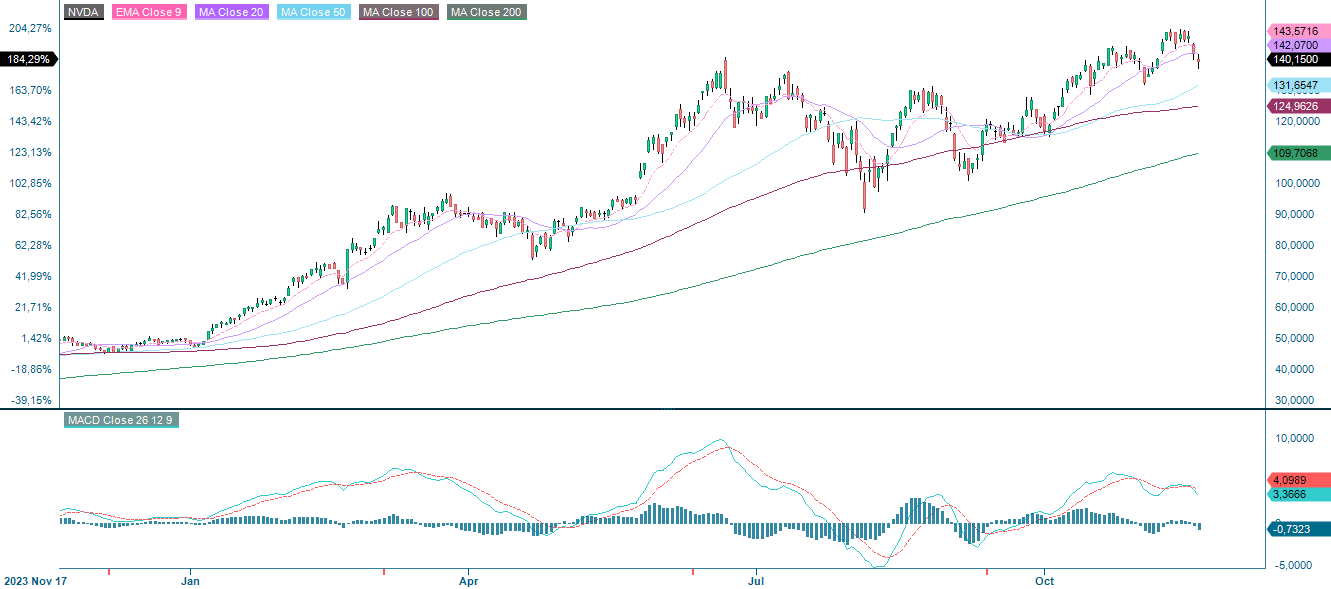
Nvidia (in USD), five-year weekly chart

Macro comments
We wrote last week about the rise in US interest rates following Donald Trump's victory in the US presidential election. Powell signalled on Thursday 14th November that the Federal Reserve (Fed) is in no hurry to cut its key interest rates. The rise in interest rates has been fairly concentrated on US government bonds. Interest rates on US corporate bonds and government bonds in Sweden and Germany have not risen very much.
The stock market rally that followed the Republican victory in the US elections in early November faded last week. However, a strong report from Disney gave the New York stock market a boost. This week the focus will be on Nvidia's interim report today, Wednesday 20 November.
US, Eurozone and UK manufacturing PMIs, November 2022 to November 2024 (forecast)

Today, Wednesday 20 November, we get Consumer Price Index (CPI), Producer Price Index (PPI) and Retail Sales for October from the UK. Germany will also release its PPI for October early in the morning. The day continues with construction output for September from the Eurozone. In the afternoon, we get weekly oil inventories (Department of Energy) from the United States. There will also be interim reports from Nvidia, NIO, TJX, Palo Alto Networks, Snowflake and Target.
Thursday 21st November will see the release of the French Industrial Expectations for November. From the US, we get the Philadelphia Fed index for November, initial jobless claims, existing home sales and leading indicators for October, as well as the Kansas City Fed index for November. Baidu, Deere and Intuit are also due to release interim reports. Alfa Laval will host a Capital Markets Day.
Friday 22 November starts with the October CPI from Japan. Otherwise, Friday is dominated by November Purchasing Managers’ Index (PMI) figures from Japan, India, France, Germany, the Eurozone, the UK and the US. Elsewhere on Friday's agenda, UK retail sales for October and Confederation of British Industry’s (CBI) industrial trends for November are due. Germany's Q3 Gross Domestic Product (GDP) is also due. The US will bring the Michigan index for November
Will Nvidia fuel the indices?
The S&P 500 is trading below the MA20 ahead of the Nvidia report. The first level of support on the downside is at 5,821 where the MA50 meets, followed by 5,680 where the MA100 meets. The previous high at 6,030 acts as the first level of resistance on the upside
S&P 500 (in USD), one-year daily chart

S&P 500 (in USD), weekly five-year chart
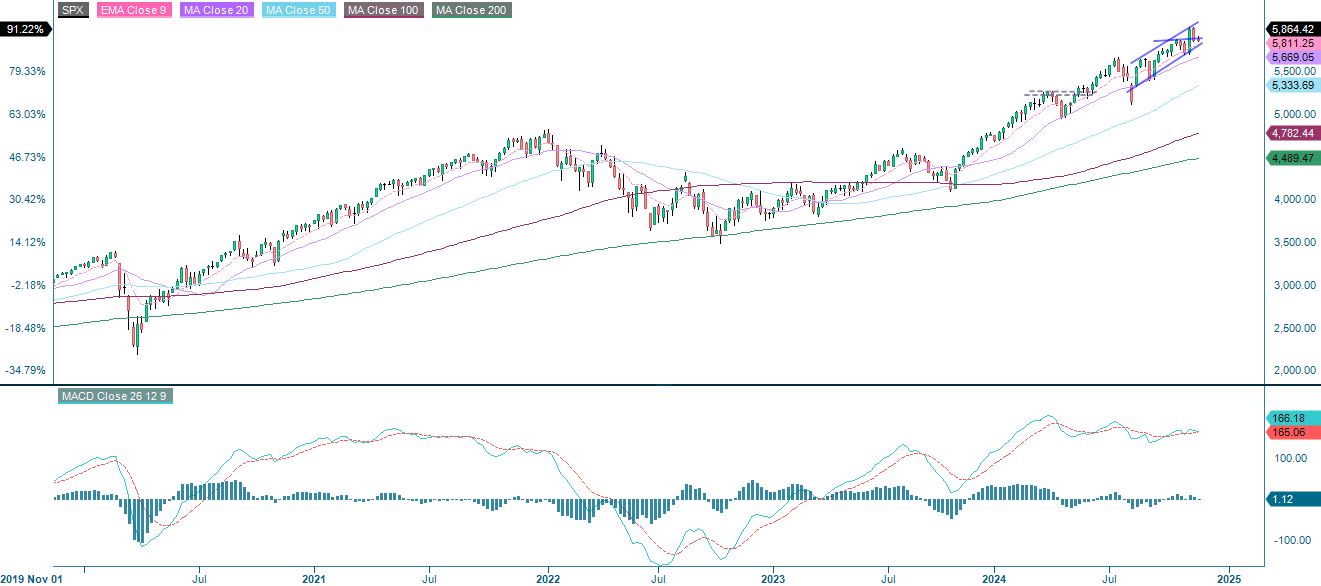
For the Nasdaq 100, the MA50 currently stands at 20,140 and the MA100 at 19,761, acting as the first and second levels of support on the downside.
Nasdaq 100 (in USD), one-year daily chart

Nasdaq 100 (in USD), weekly five-year chart

The German DAX is currently trading at support and may look a little more attractive for a long position compared to the OMXS30. This is from a risk/reward perspective as the next level of support is around 18,750 while the upside potential is the previous high around 19,650.
DAX (in EUR), one-year daily chart
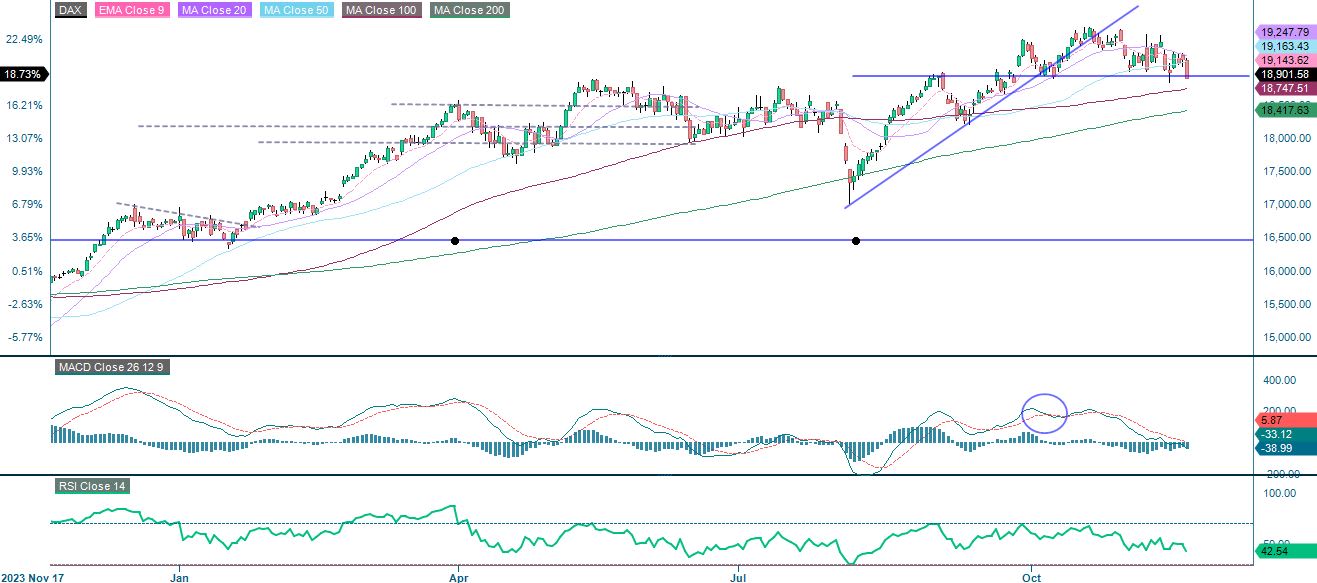
DAX (in EUR), weekly five-year chart
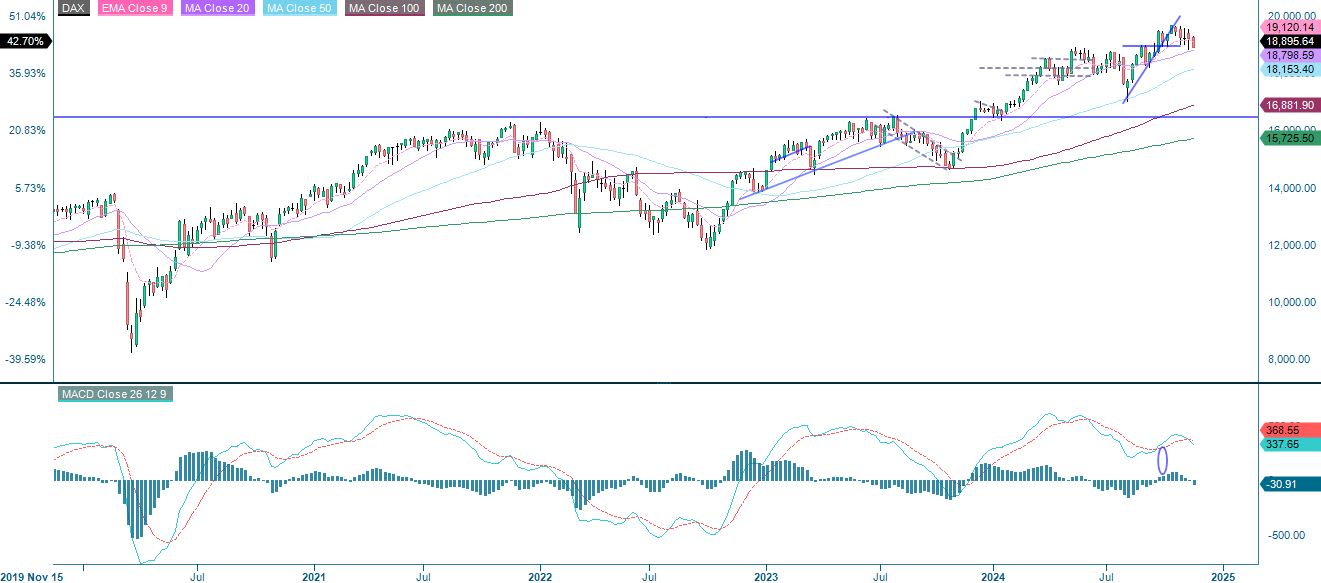
The OMXS30 is trading below resistance at 2,490. This may look like an interesting entry point, but it is very risky as the next level is around 2,400. Meanwhile, the upside potential for a long trade is limited to around 2,555 where the first level of resistance is found.
OMXS30 (in SEK), one-year daily chart

OMXS30 (in SEK), weekly five-year chart
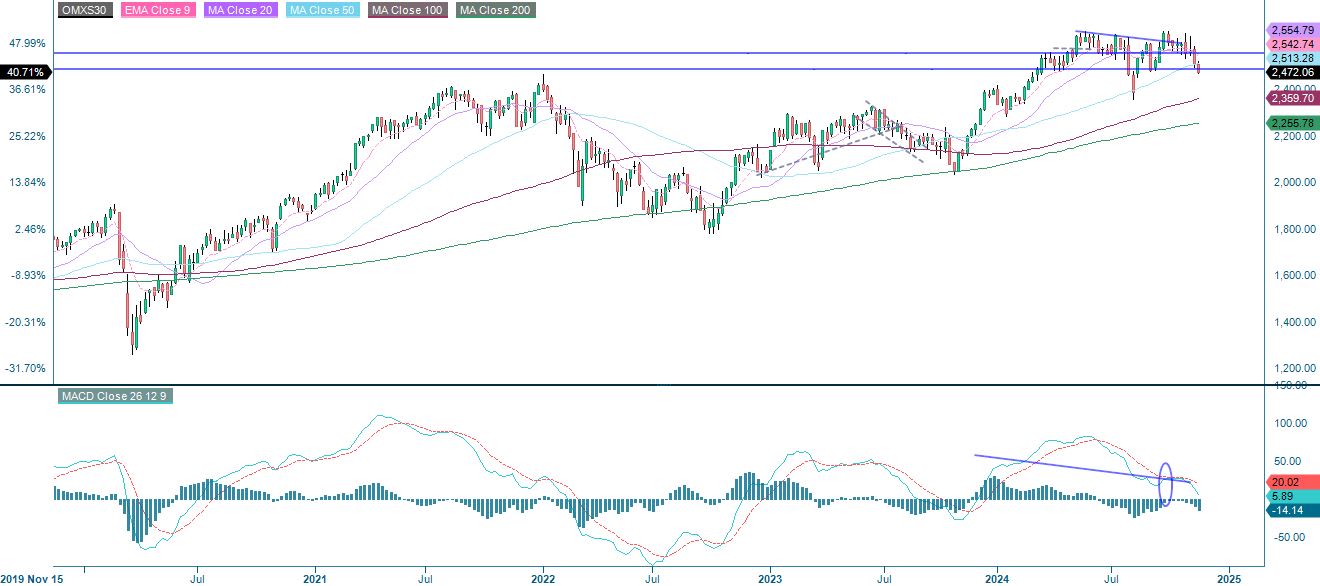
The full name for abbreviations used in the previous text:
EMA 9: 9-day exponential moving average
Fibonacci: There are several Fibonacci lines used in technical analysis. Fibonacci numbers are a sequence in which each successive number is the sum of the two previous numbers.
MA20: 20-day moving average
MA50: 50-day moving average
MA100: 100-day moving average
MA200: 200-day moving average
MACD: Moving average convergence divergence
Risks
Credit risk of the issuer:
Investors in the products are exposed to the risk that the Issuer or the Guarantor may not be able to meet its obligations under the products. A total loss of the invested capital is possible. The products are not subject to any deposit protection.
Currency risk:
If the product currency differs from the currency of the underlying asset, the value of a product will also depend on the exchange rate between the respective currencies. As a result, the value of a product can fluctuate significantly.
External author:
This information is in the sole responsibility of the guest author and does not necessarily represent the opinion of Bank Vontobel Europe AG or any other company of the Vontobel Group. The further development of the index or a company as well as its share price depends on a large number of company-, group- and sector-specific as well as economic factors. When forming his investment decision, each investor must take into account the risk of price losses. Please note that investing in these products will not generate ongoing income.
The products are not capital protected, in the worst case a total loss of the invested capital is possible. In the event of insolvency of the issuer and the guarantor, the investor bears the risk of a total loss of his investment. In any case, investors should note that past performance and / or analysts' opinions are no adequate indicator of future performance. The performance of the underlyings depends on a variety of economic, entrepreneurial and political factors that should be taken into account in the formation of a market expectation.
Market risk:
The value of the products can fall significantly below the purchase price due to changes in market factors, especially if the value of the underlying asset falls. The products are not capital-protected
Product costs:
Product and possible financing costs reduce the value of the products.
Risk with leverage products:
Due to the leverage effect, there is an increased risk of loss (risk of total loss) with leverage products, e.g. Bull & Bear Certificates, Warrants and Mini Futures.
Disclaimer:
This information is neither an investment advice nor an investment or investment strategy recommendation, but advertisement. The complete information on the trading products (securities) mentioned herein, in particular the structure and risks associated with an investment, are described in the base prospectus, together with any supplements, as well as the final terms. The base prospectus and final terms constitute the solely binding sales documents for the securities and are available under the product links. It is recommended that potential investors read these documents before making any investment decision. The documents and the key information document are published on the website of the issuer, Vontobel Financial Products GmbH, Bockenheimer Landstrasse 24, 60323 Frankfurt am Main, Germany, on prospectus.vontobel.com and are available from the issuer free of charge. The approval of the prospectus should not be understood as an endorsement of the securities. The securities are products that are not simple and may be difficult to understand. This information includes or relates to figures of past performance. Past performance is not a reliable indicator of future performance.
© Bank Vontobel Europe AG and/or its affiliates. All rights reserved.
